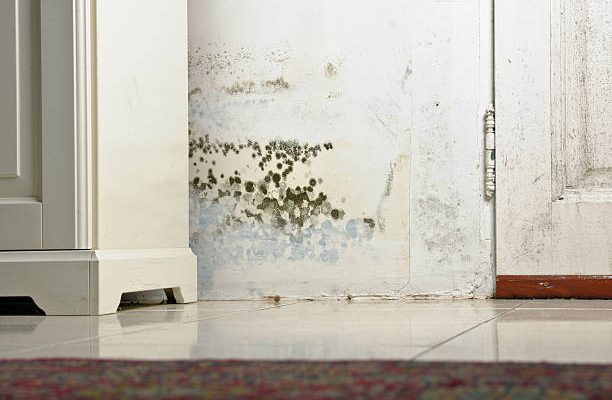I. Introduction
Mold is a common problem that can not only ruin the look and feel of your home but can also damage your health. Mold is a fungus that grows in damp and moist places and can cause a variety of health difficulties. It can also produce a musty smell, discolor walls and floors, and cause discoloration and staining. Removing mold stains can be tricky and time-consuming, but it is a necessary step in preventing further growth and damage. In this article, we will discuss the causes behind it and what you need to know about removing mold stains from your home.
II. Causes of Mold Stains
A. Moisture
Moisture is the leading cause of mold stains and is often the result of water leakage, flooding, or high humidity levels. When moisture accumulates in an area, it creates the perfect environment for mold and mildew to grow and spread, leaving behind unsightly stains. In order for mold and mildew to thrive, there must be at least 70% humidity present for a period of 24 to 48 hours. This is why it is so important to keep your home dry and well-ventilated.
B. Humidity
Humidity is another major cause of mold stains. High humidity levels can cause water to condense on walls and ceilings, which creates the perfect environment for mold and mildew to thrive. Humidity can come from a number of sources, including steam from showers, cooking, and laundry, as well as damp air coming in through windows and doors. In order to prevent mold and mildew, it is essential to keep humidity levels as low as possible, ideally between 30% and 50%.
C. Poor Ventilation
When air is unable to circulate properly throughout a home, it can cause moisture to accumulate in certain areas, creating the perfect environment for mold and mildew to thrive. Poor ventilation can be caused by blocked air vents, inadequate insulation, or malfunctioning air conditioning and heating systems. In order to prevent mold and mildew, it is important to ensure that air is able to circulate properly throughout your home.
III. Identifying and Locating Mold Stains
A. Signs of mold
Mold doesn’t necessarily grow on a specific surface but on any. It can come in a variety of colors, including green, black, white, or yellow. It often has a musty smell that can be detected in the air, and it can also leave behind a slimy residue. Mold growth is indicated by its fuzzy, discolored appearance. When touched, the surface may feel damp or sticky. Mold can also cause discoloration on walls and ceilings, as well as health problems in people with allergies or asthma.
B. Places where mold is likely to be found
Mold is frequently found in areas that are damp and humid, such as basements, bathrooms, and attics. It can also be found in areas that are exposed to moisture, such as around leaky windows or pipes. Mold can also grow on damp clothing, shoes, and furniture. It is also possible for mold to grow in areas that are not visible to the eye, such as behind walls and under carpets. In order to identify and locate mold stains, it is important to inspect areas of the home regularly for any signs of moisture or mold growth.
IV. Steps for Removing Mold Stains
Use Protective Gear
Before attempting to remove mold stains, it is significant to protect yourself from potential exposure to the mold and its spores. Wear long sleeves, long pants, a face mask, and rubber or plastic gloves.
Clean the Moldy Surface
Before disinfecting the area, it is essential to remove any dirt and debris from the moldy surface. Use a soft brush to gently scrub the surface, taking care to avoid spreading the mold to other areas. Vacuum the area to remove any remaining dirt, dust, and other particles.
Disinfect the Area
Once the moldy surface is clean, it is critical to disinfect the area. Use a natural mold-removal product to kill and remove mold or mold spores. Follow the instructions closely, as the concentration and usage instructions may vary depending on the product. Check usenzyme.com, to find professionally built non-toxic solutions for mold problems.
Remove Any Remaining Mold and Spores
Once the moldy surface has been disinfected, use a damp cloth to gently wipe away any remaining mold or spores. It may take several passes to remove all the mold or spores. Once you are satisfied that the area is clean, dry the surface with a clean cloth or paper towel.
V. Tips for Preventing Mold Stains
A. Controlling moisture and humidity is key to preventing mold stains from forming. The best way to do this is to keep the area dry and well-ventilated. If necessary, use a dehumidifier and/or air conditioner to remove excess moisture from the air. Make sure to regularly clean and inspect areas that are prone to mold growth, such as bathrooms, kitchens, and basements. If you notice any signs of mold, address the issue quickly by cleaning the affected area with a mold-killing solution and drying it completely.
B. Increasing air circulation in your home is another effective way to prevent mold stains. Make sure that your home is properly ventilated, and consider using exhaust fans and open windows to help keep air circulating. Additionally, you should move furniture away from walls and check for any blockages in air vents and ducts that could be limiting airflow.
C. Regularly cleaning and inspecting areas that are prone to mold growth is essential for preventing mold stains. Be sure to pay special attention to bathrooms, kitchens, and basements, as these areas are especially vulnerable to mold. Clean these areas regularly with a mold-killing solution, and use a dehumidifier and/or air conditioner to reduce the moisture in the air.
D. Using a dehumidifier and/or air conditioner can be a great way to prevent mold stains from forming. Dehumidifiers and air conditioners help reduce the amount of moisture in the air and can make it more difficult for mold to grow and spread. Additionally, running a dehumidifier can help reduce the amount of dust and allergens in the air, which can also help prevent mold stains.
VI. Conclusion
Following the steps in this article can help to effectively remove mold stains and prevent their recurrence. Using the right products and techniques can ensure that mold is removed without causing any additional damage to the surface. Additionally, preventive measures such as proper ventilation and moisture control can help to reduce the likelihood of mold growth. Taking these steps can help to protect people’s health and ensure that surfaces stay clean and safe.




















